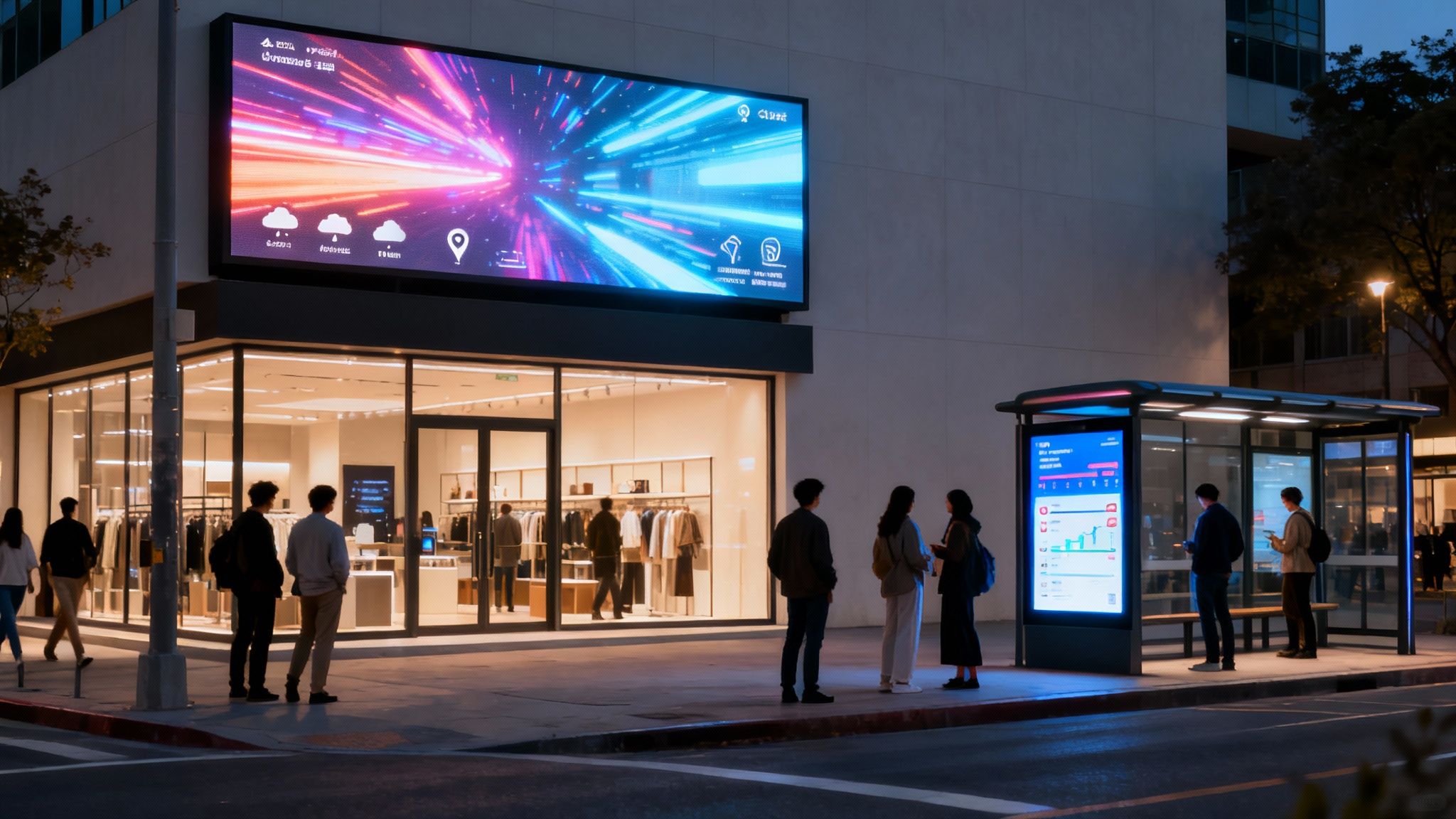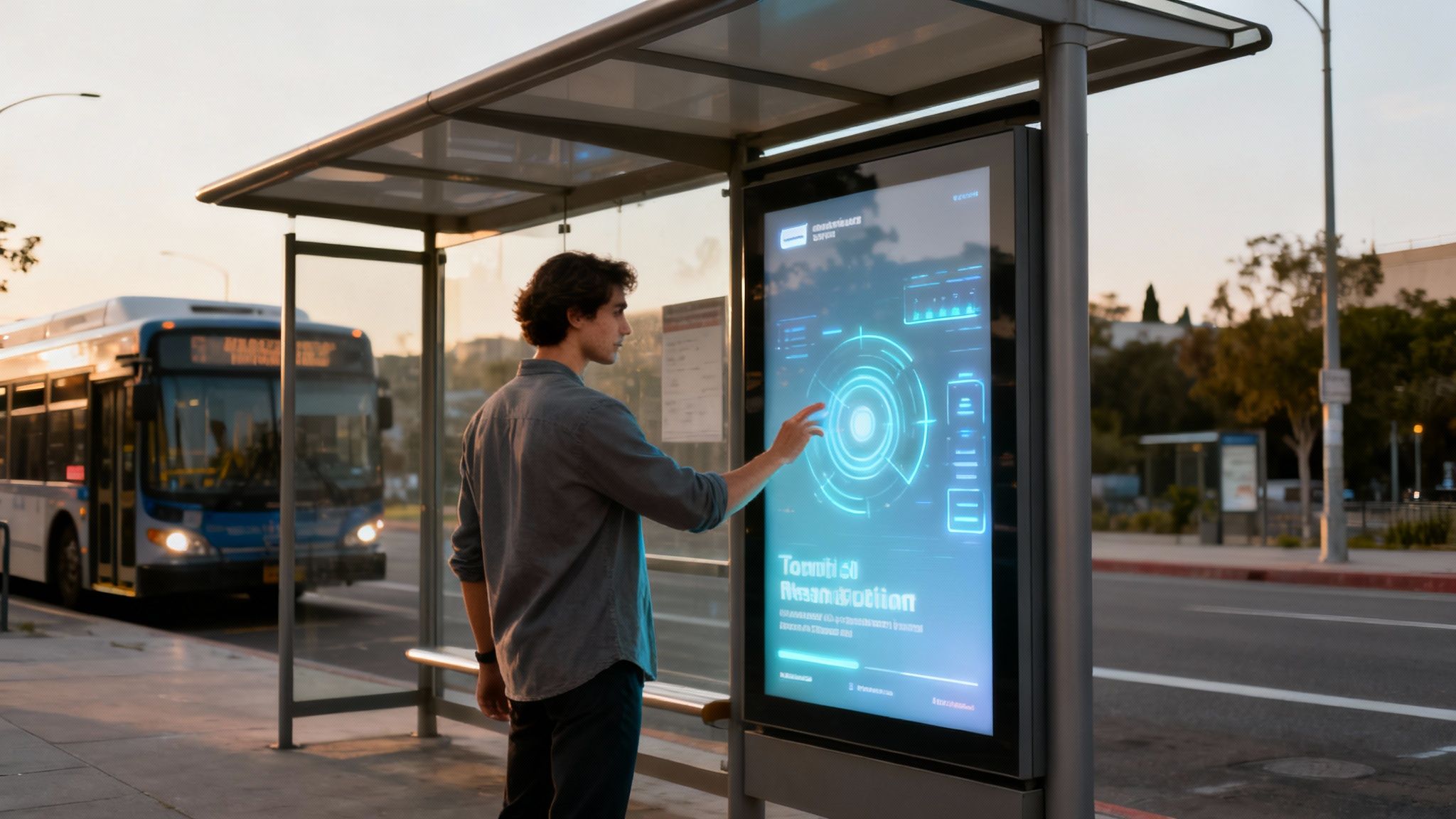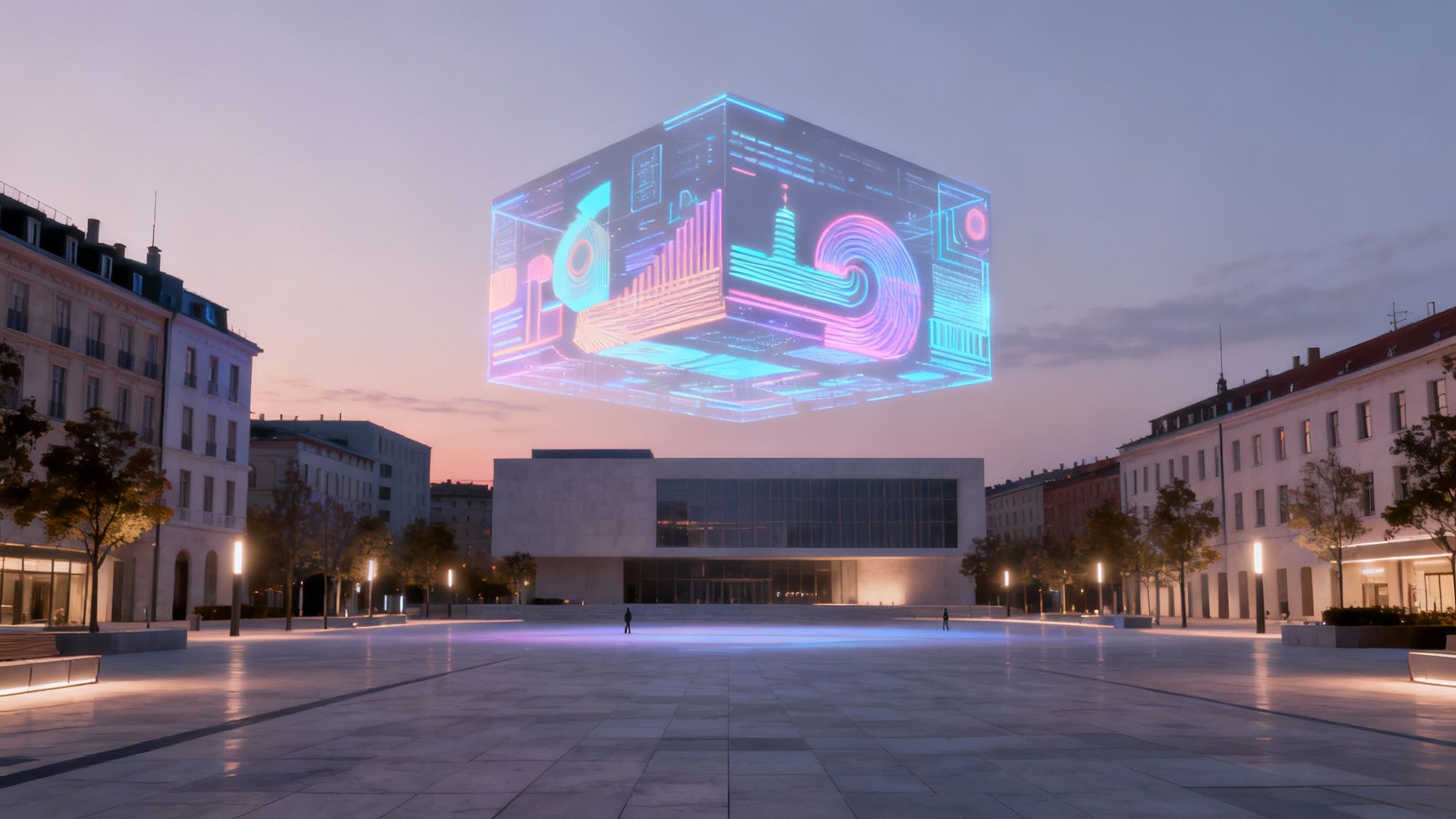

You've seen them a million times: the classic, paper-and-paste billboards lining the highway. Now, imagine that same space, but it’s a living, breathing screen—one that can speak directly to the people walking by.
That’s the magic of Digital Out of Home (DOOH) advertising. It’s where the physical world collides with digital intelligence.
 In an era of increasing online privacy concerns, DOOH effectively reaches customers by creating unskippable moments that connect with people in public spaces. This guide explores the technology behind these smart screens and explains their value for retailers and CPG brands, highlighting DOOH's evolution from simple digital posters to data-driven marketing channels.
In an era of increasing online privacy concerns, DOOH effectively reaches customers by creating unskippable moments that connect with people in public spaces. This guide explores the technology behind these smart screens and explains their value for retailers and CPG brands, highlighting DOOH's evolution from simple digital posters to data-driven marketing channels.
People are increasingly avoiding online ads through ad-blockers, skipping videos, and ignoring sponsored posts. In contrast, Digital Out-Of-Home (DOOH) ads are unavoidable in places like malls and bus stops, making them an effective way to build brand awareness. Retailers often overlook this reliable channel to make a strong impression.
DOOH ads are effective because:
High Visibility: They are placed in high-traffic areas like airports and train stations, ensuring they are seen.
Brand Safety: Ads are displayed in premium locations without the risk of inappropriate online content.
Consumer Trust: 73% of US consumers view DOOH ads favorably, a much higher rate than for social media or online ads.
Think of it as the intersection of real-world visibility and digital intelligence—a space where CPG brands can reach consumers at just the right moment with just the right message, right at the point of purchase.
The shift to DOOH is a significant market change, attracting substantial investment because it's effective. Media buyers appreciate its integration with mobile retargeting and its measurable outcomes. The global DOOH advertising market, valued at USD 20.74 billion in 2024, is projected to reach USD 39.12 billion by 2030, driven by its flexibility and relevance to consumers' current activities. Discover more insights on DOOH market growth.
Global companies like Unilever and Heineken are investing in DOOH campaigns, recognizing that a well-placed smart screen creates an experience beyond just advertising.
To understand the power of digital out of home advertising, consider its foundation: digital screens connected to a central Content Management System (CMS), which directs the display content.
The exciting part is programmatic DOOH. Unlike traditional billboard rentals, advertisers bid in real time for audience attention across a broad network of displays, from in-store screens to airport lounges, marking a significant change in how ad space is purchased.
In real-time bidding, different platforms interact to display the right ad on the right screen:
Demand-Side Platform (DSP): Used by advertisers to set up campaigns, target audiences, and bid on suitable ad slots automatically.
Supply-Side Platform (SSP): Used by media owners to offer their digital ad inventory to buyers.
Ad Exchange: Serves as the digital marketplace connecting DSPs and SSPs, facilitating the bidding process.
The auction quickly displays the highest-paying, most relevant ad through an automated, data-driven process, enhancing DOOH's efficiency. This infographic contrasts traditional outdoor ad buying with the new programmatic approach.

As you can see, programmatic completely changes the game. DOOH is no longer a static, one-to-many broadcast. It’s a dynamic channel that can adapt its message on the fly.
Programmatic DOOH uses data triggers to enhance ad relevance without personal tracking. Brands employ these strategies:
Geofencing: Set digital boundaries around locations to target ads, like a retailer advertising near a competitor's store.
Dayparting: Schedule ads for optimal times, such as a coffee shop promoting breakfast deals during morning commutes.
Weather-Based Targeting: Use live weather data to activate ads, like a soup brand advertising when temperatures drop below 50°F.
These methods make ads feel like timely, helpful suggestions rather than interruptions.
Consumer attention is crucial in today's world of ad-blockers and endless social media feeds. Digital out of home advertising stands out because it can't be ignored. Large dynamic screens in busy areas like airports and malls capture attention effectively by integrating brands into everyday life.
The key advantage of DOOH is its high visibility. Unlike ads you can ignore, these large, bright displays demand attention, enhancing brand recall. The real strength of programmatic DOOH lies in its contextual relevance, allowing messages to be triggered by real-world events. For example:
Time-Based: A coffee brand can target the morning commute with ads at bus shelters from 7 to 9 AM.
Weather-Triggered: A retailer can promote umbrellas when it rains or ice cream in sunny weather.
Event-Driven: A sports drink brand can display ads around a stadium on game day.
This approach is smart and timely, which is why 73% of US consumers view DOOH ads favorably.
The move from static billboards to dynamic digital screens is completely changing the game. By 2025, the outdoor advertising market is projected to hit USD 43.34 billion globally. The flexibility and data-driven nature of DOOH are driving much of this growth, and you can explore more insights on the outdoor advertising market to see where things are headed.
DOOH rarely functions alone; it initiates a broader omnichannel approach. It guides consumers from public spaces to personal devices, eventually leading them to your store or website. For instance, a dynamic ad for a Unilever product in a grocery aisle can prompt someone to buy the item, search for a recipe, or share on social media. DOOH starts the interaction, while other digital channels maintain it. Retailers and CPG brands benefit from this link, as an ad at a bus stop can lead to a mobile search and an in-store visit, which can be tracked with footfall attribution.

Theory and tech are valuable, but the true impact of digital out of home advertising emerges in real-world settings. Here, strategy meets creativity, turning public spaces into memorable brand experiences.
Consider the glowing billboards in Times Square or the smart screens in airports, gyms, and local shops. Big brands use DOOH to achieve precise, measurable targets. Let's explore some concrete examples of this.
When brands aim for a significant impact, they opt for large-format DOOH like digital billboards and building wraps, which integrate into the city skyline and showcase captivating content. Netflix excels at this, often using high-traffic locations like Times Square for major show launches with stunning 3D anamorphic billboards that captivate and encourage sharing.
Objective: Create buzz and awareness for a new series.
Strategy: Feature 3D creative on a renowned screen to generate a shareable "wow" moment.
Result: Campaigns typically go viral, gaining millions of organic social media views, surpassing in-person reach.
Place-based DOOH focuses on subtly delivering messages in specific locations like gyms, airports, or gas stations. Heineken effectively used this in airports for its non-alcoholic beer, targeting travelers in departure lounges who might want a relaxing drink without alcohol.
Objective: Encourage trying and considering the non-alcoholic option.
Strategy: Advertise in airport lounges, promoting the beer as a smart, refreshing pre-flight choice.
Result: Reached a relevant audience at a critical moment, increasing brand recall and influencing purchases at airport bars.
Let's break down exactly how it’s done.
A brand lift study provides a clear method to assess your campaign's impact by comparing two groups:
Exposed Group: Individuals confirmed to be near your DOOH ads.
Control Group: Similar demographics but no exposure to your ads.
We survey both groups on brand metrics, and the difference in responses, known as the "lift," measures the campaign's effect on brand awareness, ad recall, or purchase intent. For instance, a 13% increase in brand awareness among the exposed group indicates your campaign's success.
For businesses with physical locations, foot traffic is crucial. Footfall attribution links DOOH ad exposure to store visits, helping retailers and CPG brands determine ad effectiveness. It uses anonymized mobile location data to map and measure the increase in store visits attributed to the ads.
A quick-service restaurant's DOOH campaign could lead to a 25% increase in store visits within 48 hours, shifting DOOH from mere branding to a direct sales driver.
The ripple effect of a great DOOH ad doesn't stop at the store entrance; it often sparks action online. By connecting your DOOH campaigns with your other analytics platforms, you can track all sorts of valuable digital conversions. For a deeper dive, you can also explore resources that help you calculate marketing ROI for your campaigns to get the complete financial picture.
Here are a few key digital outcomes you can track:
Website Visitation Increase: Analyzing web traffic from areas where ads were placed reveals a noticeable rise in site visits from likely exposed individuals.
Mobile App Downloads: Collaborating with mobile measurement partners enables direct attribution of new app installs to users exposed to your DOOH campaign.
Online Search Activity: Tracking search trends for your brand or keywords in targeted areas shows increased interest coinciding with ad placements, using tools like Google's.

By integrating these measurement methods, you gain a comprehensive view of your campaign's performance, demonstrating the tangible results of your digital out-of-home investment.

The boundary between our physical and digital lives is increasingly merging, with digital out of home advertising at the forefront. Looking forward, public space advertising will advance due to technology enhancing brand messages to be more personal and immersive. The goal isn't to add more screens, but to make existing ones smarter, transforming them into platforms for authentic brand storytelling.
One of the most exciting developments is how artificial intelligence is being woven into the fabric of DOOH. A huge part of the future here involves innovations like AI-driven real-time user behavior analysis. This technology enables screens to adjust their display using anonymized audience data, offering highly relevant experiences. Screens can modify messages based on crowd mood or foot traffic, making ads feel more informative than intrusive. Content is also becoming more immersive, as seen with 3D anamorphic billboards that create striking optical illusions, often going viral and extending a campaign's reach
The expansion of 5G will enable richer experiences, allowing DOOH to support augmented reality and live events, transforming viewers into participants. As technology advances, trust becomes essential. The future of DOOH will rely on:
Sustainability: Emphasizing energy-efficient screens and carbon-neutral operations to align with consumer values.
Data Privacy: Maintaining consumer trust through privacy-focused, anonymized data targeting instead of personal identifiers.
The future of DOOH is a powerful blend of breathtaking creativity and intelligent, responsible technology. It’s about creating public spaces that are not just advertised in, but are genuinely enhanced by a brand's presence.
Ready to bring the power of digital advertising into your physical stores? Intouch.com transforms your retail space into a dynamic media channel, delivering targeted ads that drive sales and enhance the shopper experience. Discover how our AI-driven network can boost your in-store revenue today.